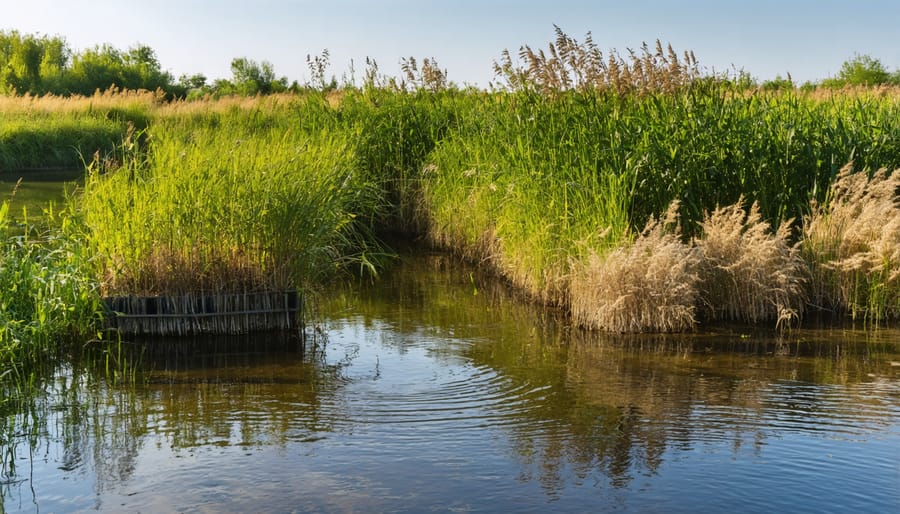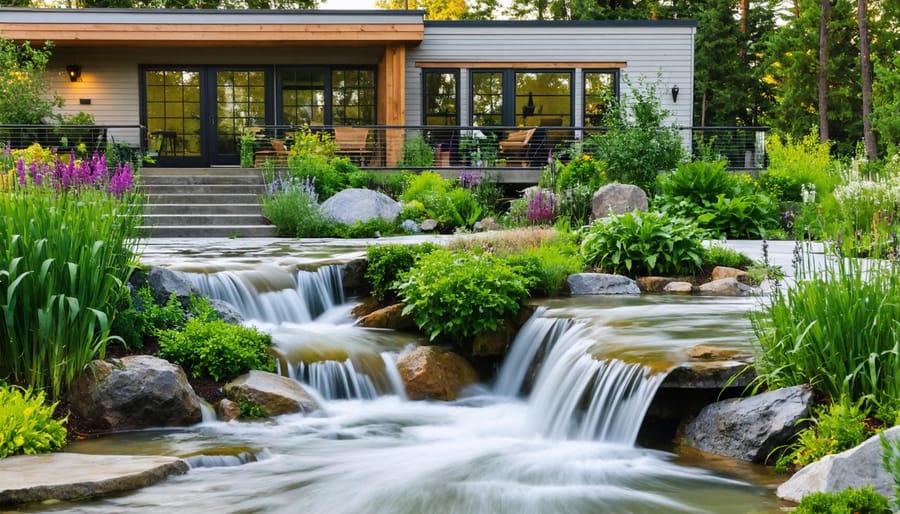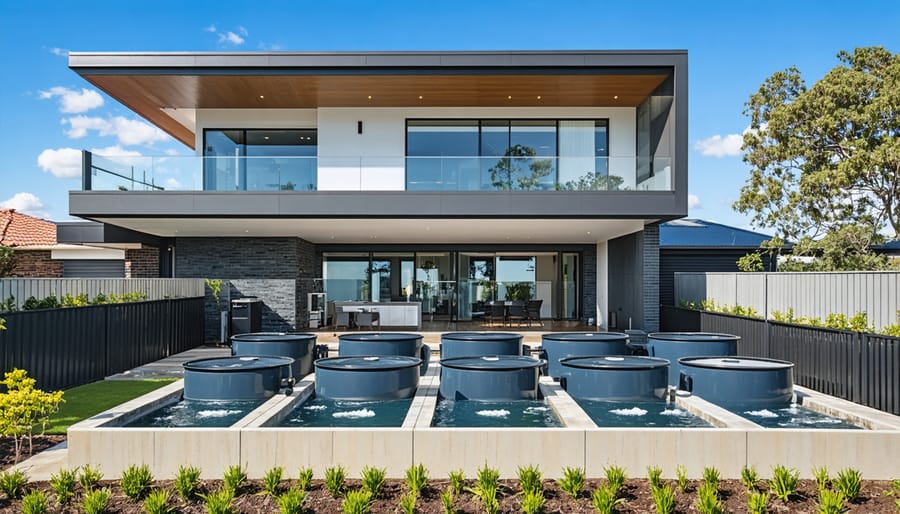As Australia grapples with increasing water scarcity and environmental challenges, eco-friendly wastewater treatment systems have emerged as a crucial solution for sustainable water management. These innovative systems not only protect our precious waterways but also offer significant cost savings for households and businesses across the country.
From the sun-scorched outback to our bustling coastal cities, Australians are discovering that green wastewater treatment technologies can transform what was once considered waste into a valuable resource. Modern eco-friendly systems harness natural processes like biological filtration and UV disinfection, reducing energy consumption by up to 50% compared to traditional treatment methods while producing cleaner water that can be safely returned to the environment or repurposed for irrigation.
The shift towards sustainable wastewater management isn’t just an environmental imperative – it’s becoming a smart business decision. With water restrictions tightening and utility costs rising, investing in eco-friendly treatment systems helps future-proof properties while contributing to local water conservation efforts. These systems align perfectly with Australia’s growing commitment to environmental stewardship and our unique need to preserve water resources in one of the world’s driest inhabited continents.
Understanding Modern Eco-Friendly Wastewater Systems
Natural Filtration Systems
Natural filtration systems harness the power of nature to clean wastewater, offering an environmentally sound solution that’s perfectly suited to Australia’s climate. Reed beds and constructed wetlands are leading examples of these systems, using native plants and natural processes to filter and purify water.
Reed beds work by passing wastewater through layers of gravel and sand where specially selected plants, like Phragmites australis (common reed), grow. These plants’ root systems create the perfect environment for beneficial bacteria that break down pollutants. Meanwhile, the plants themselves absorb excess nutrients, making them particularly effective for treating greywater from households.
Constructed wetlands take this concept further by recreating natural wetland ecosystems. These systems typically feature a variety of native Australian water plants, including rushes and sedges, working together to filter contaminants. They’re not just practical – they create valuable habitat for local wildlife and can become beautiful landscape features.
Many Australian properties are now incorporating these natural systems, which require minimal energy and maintenance while providing effective treatment that meets local council requirements. The key is proper design and using plant species that thrive in your specific climate zone.

Advanced Biological Treatment
Advanced biological treatment harnesses nature’s own cleaning crew – beneficial bacteria – to break down wastewater contaminants effectively and sustainably. This process aligns perfectly with Australia’s commitment to organic waste recycling and environmental preservation.
The system employs two main approaches: aerobic and anaerobic treatment. Aerobic treatment occurs in oxygen-rich environments where bacteria thrive on breaking down organic matter, much like what happens in our bushland ecosystems. These helpful microorganisms transform pollutants into harmless by-products while reducing odours and harmful pathogens.
Anaerobic treatment, occurring without oxygen, is particularly effective for processing high-strength waste and producing biogas – a valuable renewable energy source. Many Australian farms and food processing facilities are already using this method to turn waste into energy, creating a circular economy approach to waste management.
Both systems require minimal chemical input and use significantly less energy than conventional treatment methods, making them ideal for our climate-conscious communities. The treated water can then be safely used for irrigation or released back into the environment, completing the natural cycle.
Smart Water Solutions for Your Property
Greywater Systems
Greywater systems offer an ingenious way to embrace sustainable waste management practices right at home. These systems capture and treat water from your shower, bathroom sink, and washing machine, giving it a second life in your garden or for toilet flushing.
In the Australian context, where water conservation is crucial, a properly designed greywater system can save up to 50,000 litres of water annually for an average household. The key is ensuring your system complies with local council regulations while maximising water reuse potential.
To implement a safe greywater system, start by using biodegradable, low-sodium cleaning products that won’t harm your plants. Install a basic diversion device with a filter to remove hair and particles, or invest in a treatment system for broader reuse options. Many Aussie homes successfully use subsurface irrigation systems, which safely distribute greywater to garden beds while keeping it away from edible plants and human contact.
Remember to maintain your system regularly by cleaning filters and checking pipes for blockages. During wet seasons, you can easily switch the flow back to the sewer system, ensuring your garden doesn’t become waterlogged. With proper setup and maintenance, greywater systems offer a practical way to reduce your environmental footprint while keeping your garden thriving through our harsh summers.

Rainwater Integration
In Australia’s climate, where water is precious and rainfall patterns can be unpredictable, integrating rainwater collection with wastewater treatment creates a powerful synergy for sustainable water management. By combining these systems, households and businesses can significantly reduce their environmental footprint while making the most of every drop.
The integration process starts with installing rainwater tanks to capture roof runoff, which can then be filtered and used for various non-potable purposes. This harvested rainwater can supplement the treated greywater from your eco-friendly wastewater system, providing a reliable water source for garden irrigation, toilet flushing, and outdoor cleaning.
What makes this integration particularly effective in the Australian context is the ability to switch between rainwater and treated wastewater based on seasonal availability. During wet seasons, excess rainwater can be stored for drier periods, while the treated wastewater provides a consistent backup supply.
Smart technology plays a crucial role in managing this integrated system. Automated controllers can monitor water levels and quality, switching between sources as needed and ensuring optimal usage of both rainwater and treated wastewater. This intelligent management helps maintain system efficiency while maximising water conservation.
Many Australian communities have already embraced this integrated approach, reporting up to 70% reduction in mains water consumption. Local councils often offer rebates and incentives for implementing these combined systems, making them an increasingly attractive option for environmentally conscious property owners.

Smart Monitoring Systems
In today’s digital age, smart monitoring systems are revolutionising how we manage wastewater treatment across Australia. These intelligent systems use advanced sensors and real-time data analytics to ensure your eco-friendly wastewater system operates at peak efficiency while minimising environmental impact.
Picture a network of smart sensors throughout your treatment system, continuously measuring crucial parameters like pH levels, dissolved oxygen, and flow rates. This data streams directly to your smartphone or tablet, giving you instant insights into your system’s performance. For busy facility managers and homeowners alike, this means spotting potential issues before they become problems.
Many Australian treatment facilities now use artificial intelligence to optimise their processes automatically. When water quality changes or equipment needs maintenance, the system alerts you immediately. This proactive approach not only saves time and money but also ensures consistent compliance with local environmental regulations.
These smart systems are particularly valuable in our varied Australian climate. During heavy rains or drought conditions, the monitoring system automatically adjusts treatment processes to maintain optimal performance. Some systems even integrate weather forecasts to prepare for upcoming conditions.
The best part? These monitoring solutions are becoming increasingly affordable and user-friendly. Many can be retrofitted to existing treatment systems, making them an accessible upgrade for both residential and commercial applications. With remote monitoring capabilities, you can keep an eye on your system from anywhere, ensuring peace of mind while maintaining your commitment to environmental stewardship.
Cost and Environmental Benefits
Financial Returns
When it comes to investing in eco-friendly wastewater treatment systems, the financial returns can be surprisingly impressive for Australian property owners. While the initial setup costs might range from $15,000 to $25,000 for a residential system, the long-term savings typically offset this investment within 5-7 years.
A typical household can save approximately $600-800 annually on water bills through water recycling and reuse. For businesses, these savings can scale up significantly, with some commercial installations reporting annual savings of $5,000-$15,000, depending on their water usage patterns.
The system’s energy efficiency contributes to additional cost reductions, with most eco-friendly systems using 30-40% less electricity than traditional treatment methods. This translates to around $200-300 in annual power savings for residential users.
Maintenance costs are also notably lower, averaging $300-400 per year compared to $800-1,000 for conventional systems. Many local councils offer rebates and incentives for installing eco-friendly wastewater systems, which can reduce initial costs by up to 25%.
For rural properties relying on water delivery, the savings are even more substantial. By recycling and reusing water, these properties can reduce their water delivery costs by up to 60%, representing thousands in annual savings.
Beyond direct financial returns, these systems can increase property values by 3-5%, making them an attractive investment for forward-thinking property owners.
Environmental Impact
Eco-friendly wastewater treatment systems are revolutionising the way we protect our unique Australian ecosystems. Recent studies from the CSIRO show that these systems can reduce harmful nutrient discharge into waterways by up to 95%, significantly benefiting local flora and fauna. In the Murray-Darling Basin alone, communities using these systems have reported a dramatic improvement in water quality and the return of native species.
These innovative systems help reduce water waste by enabling the safe reuse of treated water for irrigation and non-potable purposes, conserving up to 40% of household water consumption. For every 1,000 litres of water treated, approximately 700 litres can be recycled, making a substantial impact on water conservation efforts during our increasingly frequent drought periods.
The positive environmental impact extends beyond water conservation. These systems naturally filter out microplastics and emerging contaminants, preventing them from entering our oceans and affecting marine life. They also reduce greenhouse gas emissions by up to 30% compared to traditional treatment methods, as they require less energy to operate and produce fewer methane emissions.
Local wildlife corridors have shown remarkable improvement where these systems are implemented, with wetland birds returning to treated water bodies and native vegetation thriving in areas irrigated with the treated water. This creates a ripple effect throughout the ecosystem, supporting biodiversity and strengthening environmental resilience.
Local Regulations and Support
In Australia, implementing eco-friendly wastewater treatment systems involves navigating various state and local regulations designed to protect our unique environment. The good news is that there’s substantial support available for those making the switch to sustainable solutions.
Each state has specific requirements under the Environmental Protection Act, with local councils often providing additional guidelines. In New South Wales, for instance, you’ll need to obtain a Section 68 approval before installing any on-site sewage management system. Queensland residents must comply with the Queensland Plumbing and Wastewater Code, while Victorian properties require a septic tank permit from their local council.
The Australian Government offers several incentives to encourage adoption of environmentally conscious disposal methods, including wastewater treatment systems. These include tax deductions for businesses and rebates through various state-based sustainability programs. For example, the Victorian Government’s Regional Water Authority offers rebates of up to $1,500 for approved greywater systems.
Local support networks are readily available to help you navigate the installation process. Most councils provide free consultations with environmental health officers who can advise on suitable system types for your property. Additionally, industry bodies like the Sustainable Water Association of Australia offer resources and connect property owners with certified installers.
To ensure compliance and maximise available benefits:
– Contact your local council’s environmental health department
– Check state-specific rebate programs through your water authority
– Consult with licensed installers who understand local requirements
– Join local sustainability groups for shared experiences and advice
Remember that regulations and support programs are regularly updated, so it’s worth checking with your local authorities for the most current information. Many councils also offer workshops and information sessions about sustainable water management, providing valuable networking opportunities with others in your community who are making similar environmental choices.
As we’ve explored throughout this article, eco-friendly wastewater treatment systems are more than just an environmental choice – they’re a smart investment in Australia’s sustainable future. From reducing our environmental footprint to saving on water bills, these systems offer practical solutions that benefit both our communities and the planet.
The combination of natural treatment methods, advanced filtration technologies, and smart monitoring systems has made sustainable wastewater management more accessible than ever for Australian homes and businesses. By implementing these solutions, we’re not just treating water; we’re preserving our precious resources for future generations.
Remember, every step towards sustainable wastewater management counts. Whether you’re starting with simple greywater recycling or implementing a comprehensive treatment system, your actions contribute to a larger movement towards environmental stewardship in Australia.
We encourage you to take action today. Connect with local sustainability experts, explore available government rebates, and consider how you can incorporate these eco-friendly solutions into your property. Share your experiences with your community and inspire others to join the journey towards sustainable water management.
Together, we can create a positive impact on our environment while building more resilient and sustainable communities across Australia. The future of wastewater treatment is here, and it’s greener, smarter, and more efficient than ever before.
